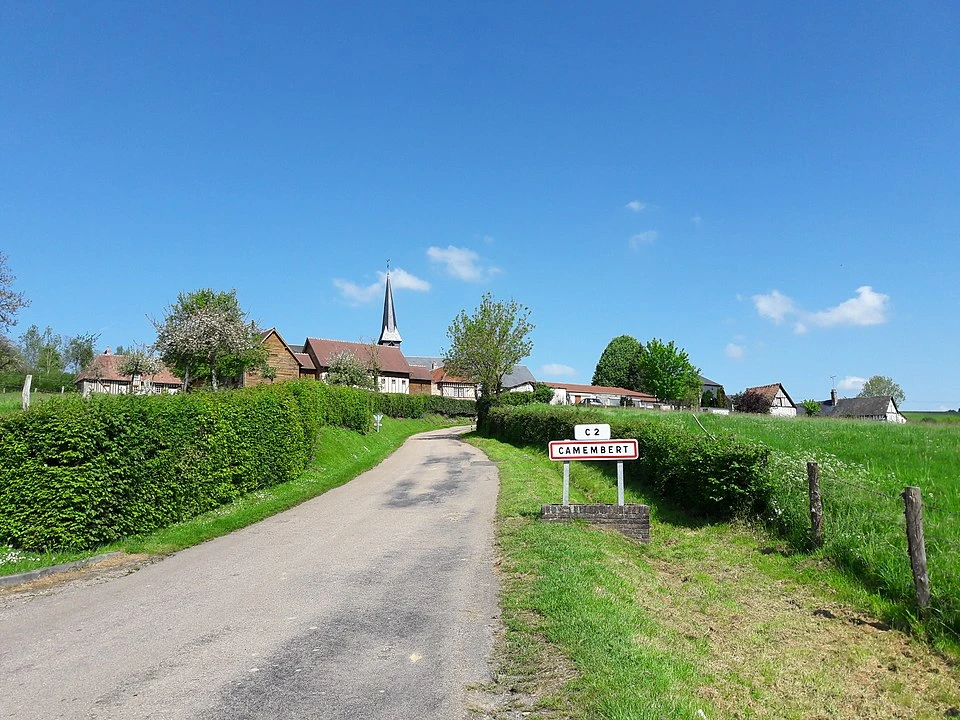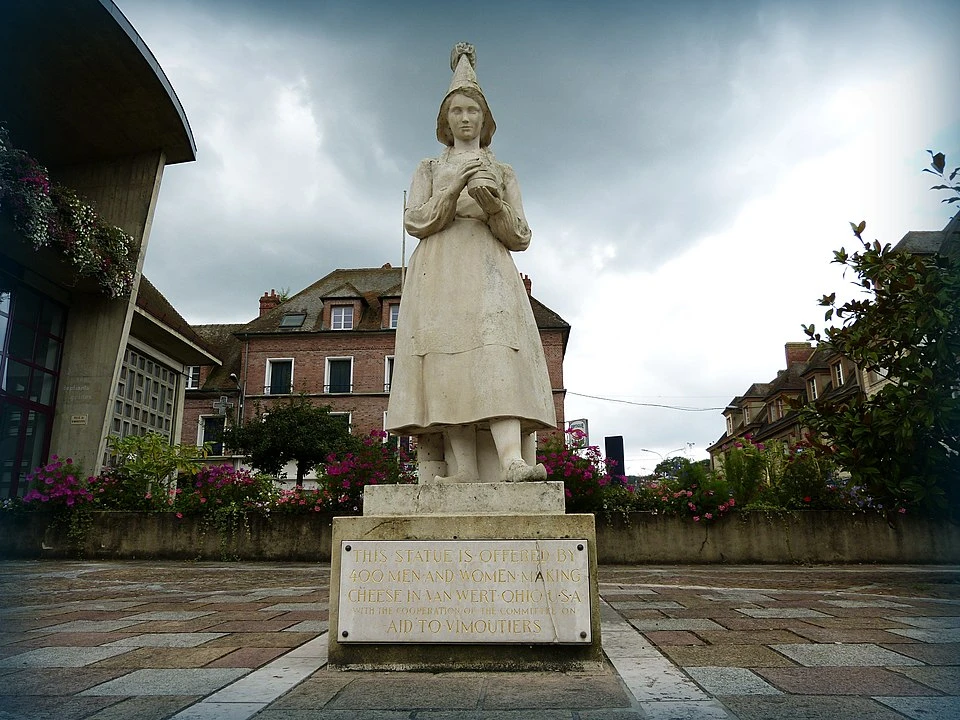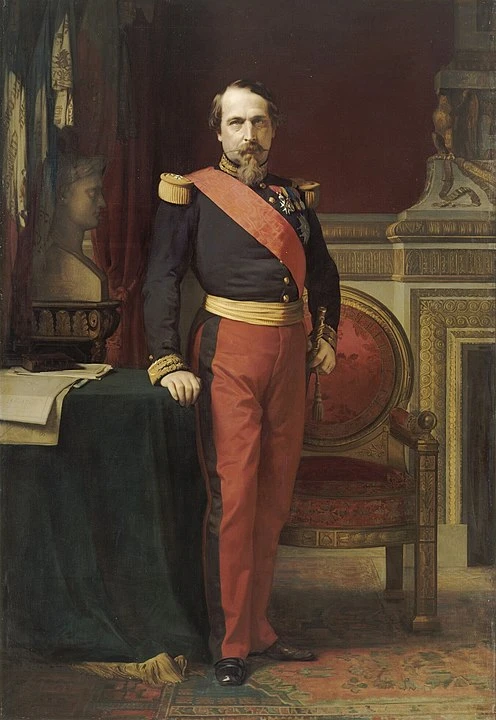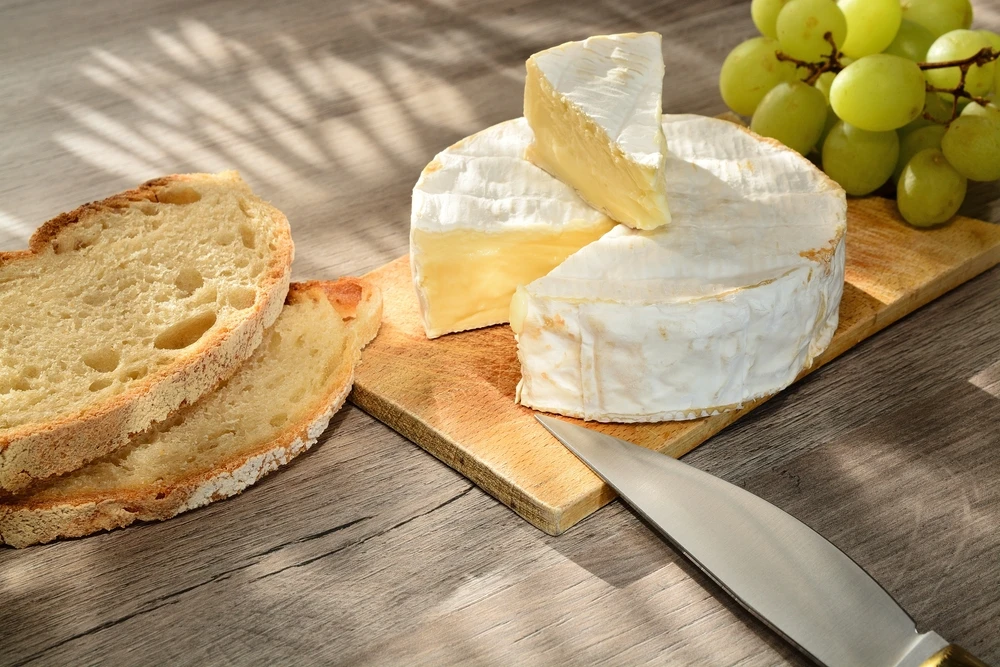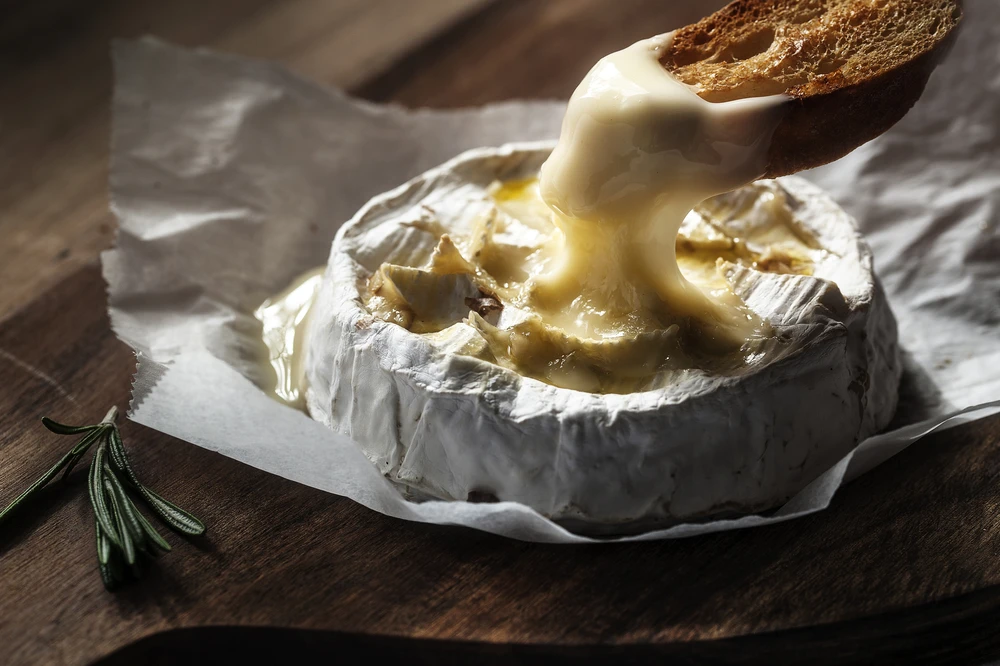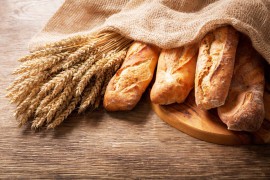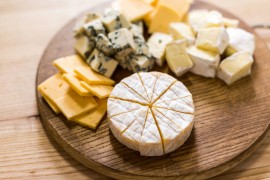🧀 History of Camembert: from Marie Harel to the Normandy PDO
Camembert: a Norman village turned symbol
Cheese has been made in this region since the dawn of time: the grass is green, fat, and the Normandy cows, with their long eyelashes and brown spots, yield a rich, creamy milk.
Normandy, divided into five departments and "pays", is home to the Pays d'Auge, a living postcard of apple trees, half-timbered houses and soothing rain.
The entrance to the village of Camembert in the Orne / By BéatriceLouise - Own work, CC BY-SA 4.0, https://commons.wikimedia.org/w/index.php?curid=48820831
The birthplace of cheese
A small commune in the Orne department, with just 176 inhabitants! Here you'll find hedges, hills, Notre-Dame church (16th-18th c.) and a stele dedicated to Marie Harel.
This is the birthplace of the cheese that took the village's name and made it famous the world over.
The legend of Marie Harel: an encounter during the French Revolution
Marie Harel: Vimoutiers statue donated by the Americans to replace the one destroyed during the Battle of Normandy in 1944 / By Marc Noordink - https://www.flickr.com/photos/marcnoordink/15085415125/, CC BY 2.0, https://commons.wikimedia.org/w/index.php?curid=58378033
The French Revolution turned ugly for priests; Marie Harel, a young farm girl, takes in one of them: father Charles Jean Bonvoust, originally from Brie - a land also known for its cheese. The priest watches Marie make her cheese and passes on a secret: refining the dough differently to create a flowery white rind. Marie listens, adjusts her recipe while keeping the base inherited from the country; the result: a cheese with a strong, flowery taste, sometimes chalky, sometimes runny, so good that she sells more and more of it.
From Napoleon III to cinema: the Camembert becomes a French symbol
In the 1850s, while visiting Argentan, he tasted Marie Harel's cheese and fell under its spell. He had some delivered to the Tuileries Palace. The cheese reached Paris: appreciated by the Emperor, it seduced Parisians. The train facilitated its distribution, and its modest price made it popular.
Portrait of Napoleon III, fan of Camembert, in the uniform of a major general in his large Tuileries cabinet (oil on canvas by Hippolyte Flandrin, 1861).
During the First World War, it was included in the rations of French soldiers; the poilus brought it home. The '30s brought it to the silver screen, then the '40s and '50s served it to the American and Allied GI's landing in Normandy. The image of the Frenchman with the beret, baguette under his arm, glass of wine and camembert was born: a national icon.
A cheese that loses fans, but not its value
With over 30,000 tons produced each year, it continues to sell, but sales are down 10%: a pity, because real farm camembert is still delicious.
How to enjoy a Camembert?
Un camembert / Image par Pro Video/Shutterstock
Choosing your Camembert cheese
The good Camembert is Camembert de Normandie AOP.
Beware of imitations! Choose it according to your taste:
-
Some call it "hard" (chalky),
-
"Well done" (flowing and fragrant) for others.
"Le camembert, ce fromage qui fleure les pieds du Bon Dieu", wrote Léon-Paul Fargue.
The more it flows, the more it tastes.
What to serve Camembert with?
- Bread, of course: baguette, rustic bread, or nut bread.
- You can add nuts, raisins or quince jam.
- Traditionally served with red wine, it also goes very well with a floral white wine or a Normandy cider.
How to use Camembert in cooking
Camembert fondue
-
Remove the packaging and leave it in its wooden box.
-
Four 180 °C / 10 minutes.
-
When it puffs up, open it with a cross: trempete bread or potatoes!
A classic to share for 4, with a green salad.
Fondue de Camembert / Image par stoica ionela/Shutterstock
Camembert croquettes
-
120 g flour, 1 plastered camembert, 1 egg white, 100 g breadcrumbs (+ chopped walnuts).
-
Cut, coat, bread, then fry at 180 °C until golden brown.
Camembert pie
-
1 camembert, 100 g bacon, 400 g broccoli, 4 eggs, crème fraîche, shortcrust pastry.
-
Arrange the vegetables and bacon, cover with slices of Camembert and pour over the egg-cream mixture.
-
Cuisson : 180 °C / 40 min.
🍽️ Questions about Camembert: what everyone wants to know
What is the origin of Camembert?
Born in the small village of Camembert, in the Orne region of France, the cheese owes its creation to Marie Harel around 1791. Following the advice of a priest from Brie, she created France's most famous bloomy-rind cheese.
What's the difference between Camembert and Camembert de Normandie AOP?
Camembert de Normandie AOP is the only true traditional Camembert. Made from raw milk in a delimited area of Normandy, it is ladled and matured for several weeks. Other Camemberts, often pasteurized, are more standardized imitations.
Can you eat the rind on Camembert?
Yes, of course! It's part of the cheese. The white, flowery rind adds subtle aromas and contributes to the cheese's unique taste.
Is Camembert better with raw or pasteurized milk?
raw milk offers a richer, more distinctive taste, with the flavors of the Normandy terroir. The milder pasteurized milk produces a regular but less expressive cheese.
How to store Camembert?
Store between 4 and 8 °C, in its original paper or greaseproof paper. Take it out 30 minutes before eating, long enough for it to reveal all its fragrance.
How to make Camembert in the oven
Place it in its wooden box (without plastic), draw a cross on the top, and bake it 10 to 15 minutes at 180°C. The center becomes melting: ideal for dipping bread, potatoes or vegetables.
What to enjoy it with?
Camembert goes wonderfully well with papain rustique, a cidre brut or a vin blanc fleuri. You can also dare to add a little quince, grape or walnut jam for a sweet-savory touch.
Why do some Camemberts have less taste?
Often because of pasteurized milk, too short a affinage or industrial manufacturing that erases flavors. The secret of a real Camembert is time and raw milk!
Can Camembert be frozen?
This is not advisable: freezing alters its texture. It's better to eat it fresh or use it cooked (fondue, pie, croquettes...).
How long does it take to refine a Camembert?
Refinement takes an average of 3 to 4 weeks

